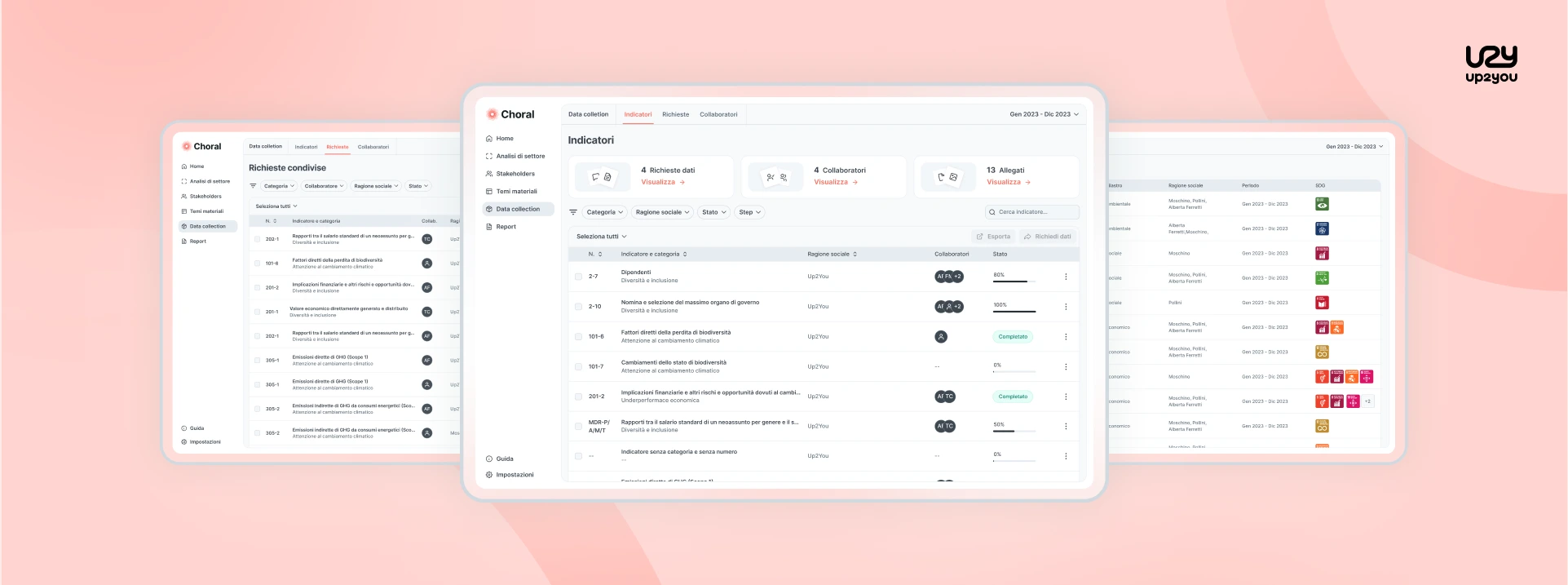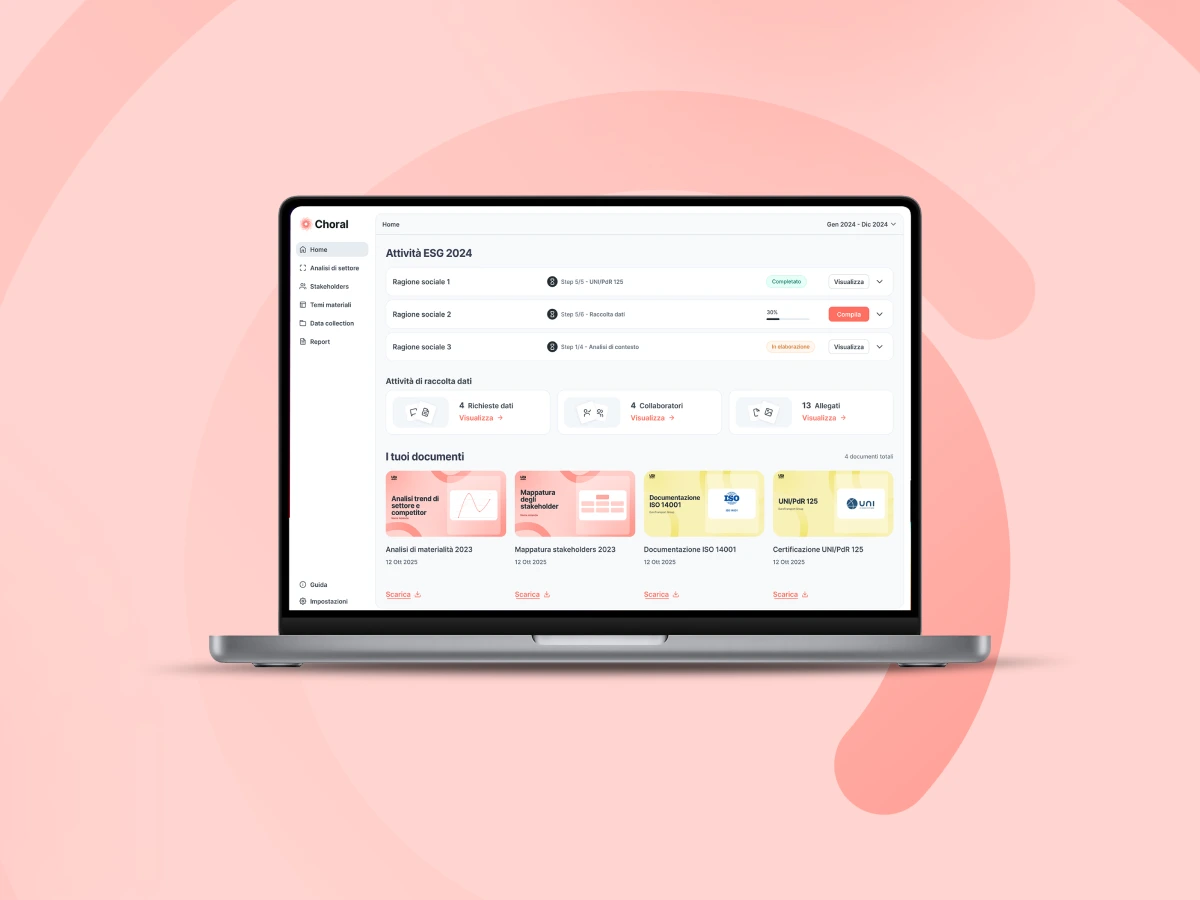{summary#bullet-1}
Why managing the ESG data of the investee companies is not an easy job
In the panorama of sustainable finance, the funds of Private Equity today they are faced with a new challenge: managing and valuing the large amount of ESG (Environmental, Social, Governance) data that comes from their investee companies.
If the regulatory compliance is now an essential requirement, the real step forward consists in transforming the collection of sustainability data into a structured process, comparable and strategic.
The quality and consistency of this information are central elements to ensure a credible and transparent reporting, able to realistically reflect the overall impact of the portfolio.
However, in practice, ESG data management still presents numerous complexities.
Le investee companies they operate in different sectors, have different sizes and levels of maturity, use heterogeneous tools and often do not have internal systems dedicated to performance measurement environmental, social and governance.
The result is a large flow of information but fragmented, difficult to standardize and consolidate efficiently. For fund managers, this means facing not only a significant operating load, but also the risk of inconsistencies in the ESG reports and of a loss of informational value along the data collection chain.
{summary#bullet-2}
ESG assessment: how to have a complete view of the portfolio
For private equity funds, a effective management of ESG data starts from the first moment a company becomes part of the portfolio. Have a structured process of ESG assessment In fact, it makes it possible to build a clear, objective and comparable photograph of the sustainability performance of the investee companies, laying the foundations for a consistent monitoring over time.
The assessment represents much more than a preliminary requirement: it is a strategic tool which makes it possible to identify strengths, risks and areas for improvement, and to guide investment decisions in an informed manner. In this sense, the ESG due diligence becomes an essential component of the analysis and selection process, to be integrated into all phases of fund management.
Let's see what are the main types of due diligence to be taken into consideration.
- DD ESG (Environmental, Social & Governance): ESG risk analysis and benchmarks against industry standards, useful for evaluating the company's degree of maturity and identifying gaps with respect to best practices.
- DD CC (Climate & Carbon): Assessment of climate risks and calculation of the carbon footprint of the target company, essential elements for estimating the resilience of the business to environmental and regulatory changes.
- DD Impact: Analysis of the social and environmental impact generated by the company, with particular attention to positive effects and sustainable value opportunities.
- DD HSE (Health, Safety & Environment): Assessment of environmental and security risks, often integrated with field audits, red flag reports or technical inspections, also in collaboration with specialized partners.
Through these analyses, funds can:
- clearly identify ESG gaps and define concrete improvement plans;
- create a comparable database between the various subsidiaries, useful for monitoring and consolidated reporting;
- promote more informed investment decisions, aligned with the strategy ESG and to the fund's overall sustainability objectives.
Ultimately, the ESG assessment is not only a technical step, but the starting point for building a structured and credible management of sustainability at the portfolio level. It is thanks to this approach that funds can combine financial due diligence with environmental and social due diligence, strengthening their ability to create value in the long term.
{summary#bullet-3}
Why create a unique and updated ESG database
One of the main obstacles in managing sustainability for private equity funds lies in fragmentation of ESG data coming from the subsidiaries.
In fact, each company uses different metrics, tools and formats for the collection and communication of its non-financial information. To this heterogeneity is often added the lack of shared standards, which makes the comparison between different realities and the creation of a coherent overall picture at the portfolio level complex.
The most common critical issues concern:
- non-uniform ESG questionnaires, often compiled inhomogeneously or with different degrees of depth;
- Absence of reference standards, which makes it difficult to align metrics with the main reporting frameworks;
- complexity in consolidating data, especially when the subsidiaries operate in different sectors or countries and use platforms that are not compatible with each other.
To overcome these barriers, funds must have a collection and management system that allows centralize ESG information in a unique and updated database, capable of aggregate data coming from the individual subsidiaries in a consistent, verifiable and comparable way. A structured archive is not only an operational support for reporting, but it becomes the fulcrum of a integrated information ecosystem, able to provide a dynamic and comparative view of the sustainability of the portfolio.
Once this solid database has been built, the next step is to activate a periodic monitoring of ESG performance. Through automated processes and predefined indicators, the fund can observe the evolution of sustainability parameters over time and objectively measure the progress made by its subsidiaries.
The main advantages of structured and automated monitoring are:
- continuous progress tracking, with the possibility of identifying emerging trends and critical issues;
- constant updating of ESG indicators, thanks to periodic collection and automatic data validation systems;
- alignment with international frameworks such as ESRS, GRI and SASB, which guarantees consistency and comparability at European and global levels.
The benefits for the fund are tangible:
- reduction of reporting times, thanks to standardized processes and always updated data;
- consistency and verifiability of information, essential for responding to the requests of investors and supervisory authorities;
- greater transparency and reliability, which strengthen the fund's reputation and consolidate the trust of stakeholders.
In this way, ESG data management evolves from a purely operational activity to a Strategic lever to improve the quality of decisions, measure the impact of the portfolio and clearly communicate the results achieved in terms of sustainability.

{summary#bullet-4}
CliMax and Choral: Up2You's platforms for the automatic management of your ESG data
Effectively managing the sustainability of a portfolio of investee companies requires technical skills, analysis skills and adequate digital tools. This is where Up2You positions itself as a strategic partner for private equity funds, offering integrated solutions that simplify the management of ESG data and transform regulatory complexity into a fluid, transparent and results-oriented process.
Thanks to its proprietary platforms, Choral and Climax, Up2You allows funds to:
- centralize ESG data collection in a single digital environment, reducing inefficiencies and improving the quality of information;
- continuously monitor sustainability performance of the subsidiaries, through dashboards and indicators aligned with the main international frameworks (ESRS, GRI, SASB, SFDR);
- simplify ESG reporting and ensure consistency with European regulatory requirements, from SFDR to CSRD, up to EU taxonomy;
- adapt the indicators and analysis models to the specific needs of the fund, creating a flexible and tailor-made measurement system.
Another fundamental aspect is the possibility of having consistent reporting, KPIs, and dashboards for all participating companies. Having a single indicator scheme allows the fund to effectively compare ESG performance of the different companies in the portfolio, ensuring consistency, transparency and ease of analysis.
The added value of Up2You, however, does not lie only in technology, but in the ability to accompany managers along the entire ESG journey thanks to a team of experts, from the first assessment to the creation of a shared language of sustainability between fund and investee companies.
In a context in which transparency and data quality are increasingly decisive elements for attracting capital and consolidating the trust of stakeholders, Up2You's solutions allow private equity funds to move from fragmented and responsive management to structured and proactive ESG governance.





























